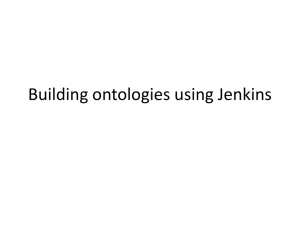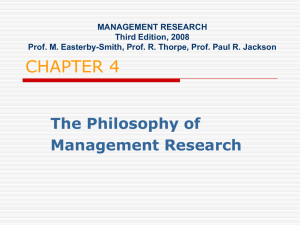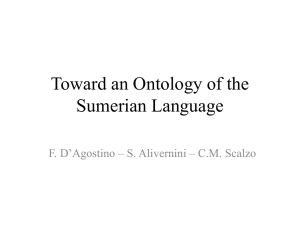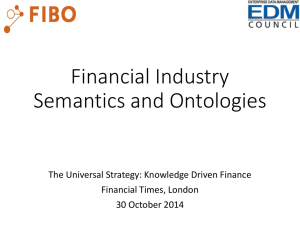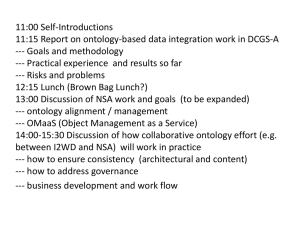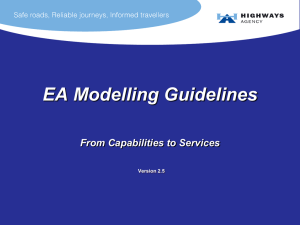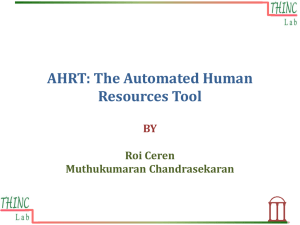Enterprise Architecture TOGAF, Zachman, FEAF
advertisement
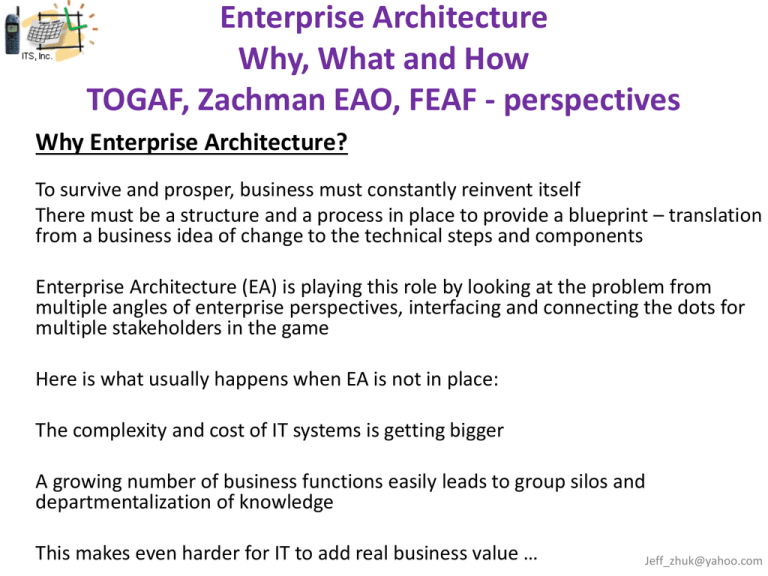
Enterprise Architecture Why, What and How TOGAF, Zachman EAO, FEAF - perspectives Why Enterprise Architecture? To survive and prosper, business must constantly reinvent itself There must be a structure and a process in place to provide a blueprint – translation from a business idea of change to the technical steps and components Enterprise Architecture (EA) is playing this role by looking at the problem from multiple angles of enterprise perspectives, interfacing and connecting the dots for multiple stakeholders in the game Here is what usually happens when EA is not in place: The complexity and cost of IT systems is getting bigger A growing number of business functions easily leads to group silos and departmentalization of knowledge This makes even harder for IT to add real business value … Jeff_zhuk@yahoo.com What is Enterprise Architecture? • Architecture: - The art and science of designing complex systems – Provides high level perspectives from different angles • Enterprise Architecture: – Became a cross-section between business and IT – A communication process and a tool for aligning business and technology from enterprise perspectives Jeff_zhuk@yahoo.com TOGAF, FEAF and Zachman EAO • EA Frameworks/Ontology or Handbooks for enterprise architects • Have different focus and can be viewed as complementary • The Open Group Architecture Framework (TOGAF) - Focuses on Enterprise Continuum with Architecture Development Method (ADM) • Federal Enterprise Architecture Framework (FEAF) – Describes the enterprise as segmented reference models – Guides on a migration process from “As Is” to “To Be” architecture – Offers approaches to cataloging assets and measuring the success of EA • Zachman Enterprise Architecture Ontology – Offers a matrix for architecture artifacts that are significant to the management of the Enterprise, as well as to the development, and to multiple stakeholders – The rows of the grid represent different “player perspectives” (owner, designer, etc.) – The columns represent “technical perspectives” (What/Data, How/Process, etc.) Jeff_zhuk@yahoo.com TOGAF: Enterprise Continuum TOGAF: Architecture Development Method (ADM) Jeff_zhuk@yahoo.com TOGAF Offers EA Methodology With General Views and Processes • • • • Business Architecture Data Architecture Applications Architecture Technical/Services Architecture Jeff_zhuk@yahoo.com Federal Enterprise Architecture Framework Describes the enterprise as five reference models: - Business - Service - Components - Technical - Data Provides a common language to describe and analyze IT investments and enhance collaboration Jeff_zhuk@yahoo.com Federal Enterprise Architecture Framework From the Federal Enterprise Architecture perspective the enterprise is built of segments There are: - Core mission-area segments, related to a specific organization or a department And - Business-services segments, that are reused across all enterprise Jeff_zhuk@yahoo.com Zachman Enterprise Architecture Ontology Zachman Enterprise Architecture Ontology • • • • Describes a matrix for EA artifacts Each row represents a stakeholder perspective Each column represents a technical view Each artifact should fit to a single specific cell • Helps to ensure existing relationships between the artifacts, confirming that technology supports business goals Jeff_zhuk@yahoo.com Zachman Enterprise Architecture Ontology • Why Ontology? • Initially Zachman’s EA Framework looked more like a taxonomy providing good places and names • The name “EA Ontology” appeared with the version 3 • The ideas associated with “Ontology”: - Not just names and places but their relationships are extremely important - Ontology model, method and language is instrumental to express EA ideas in the rich, unified and comprehensive manner, understood by people and machines Jeff_zhuk@yahoo.com Enterprise Architecture Ontology • Any difference between ontology and taxonomy? • While taxonomy focuses on the keywords, ontology includes their relationships, providing the richest knowledge expression • Ontology modeling is close to BPM but is based on the natural language (NL) and can be expressed in RDF/OWL • DoD created one of the first Enterprise Architecture ontology • Many ontologies are created in the Health Care Industry • The first standard: Financial Industry Business Ontology (FIBO) Reference: http://ITofTheFuture.com Jeff_zhuk@yahoo.com

